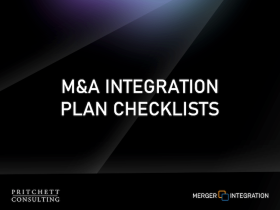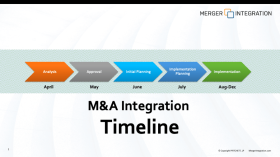The "Hard" and "Soft" Elements of M&A
HARD ELEMENTS
STRATEGY
STRUCTURE
SYSTEMS
SOFT ELEMENTS
STAFF
SKILLS
SHARED VALUES
| Item | Action |
|---|---|
| 1 | Create a Core Document that captures the business rationale for the deal. |
| 2 | Analyze the “hand you’ve been dealt” and construct a list of potential opportunities/losses. |
| 3 | Map the deal to determine how it reflects the five different types of deals. |
| 4 | Compare Acquiree’s stand-alone strategy with the new strategy for the combined organization. |
| 5 | Define and announce the leadership team of the combined organization. |
| 6 | Identify and document your customers, and develop a plan for customer retention and transition. |
| 7 | Analyze potential moves by the competition and develop a defense plan. |
| 8 | Analyze and document marketplace conditions that could impact your strategic plans. |
| 9 | Analyze and document technologies that may alter your approach to business. |
| 10 | Determine and document how value will be created and realized in the combined organization. |
| 11 | Analyze and document the impact on all stakeholders and develop a Communication Plan. |
| 12 | Create an authentic, informed, compelling, and inspirational “merger story.” |
| 13 | Define what regulations and legal guidelines may place constraints on communication. |
| 14 | Identify what regulatory approvals will be required and what legal and stakeholder requirements must be met. |
| 15 | Explain the Integration Planning Process to your workforce. |
| Item | Action |
|---|---|
| 1 | Develop process maps for all business and support workflows. |
| 2 | Develop the appropriate organizational design to support the workflow. |
| 3 | Create organizational charts (boxes only – no names) for each workflow. |
| 4 | Develop job descriptions for new jobs and harmonize existing ones. |
| 5 | Determine the strongest candidates for each position and document the selection process. |
| 6 | Develop separation plans/packages. |
| 7 | Determine if Transition Service Agreements will be required. |
| 8 | Determine if “stay incentives” will be used to retain talent. |
| 9 | Determine if voluntary separation or early retirement will be allowed. |
| 10 | Analyze any current open positions and determine if they still need to exist. |
| 11 | Determine if any temporary workers will be needed. |
| 12 | Analyze power shifts to determine the potential impact on workflows and individuals. |
| 13 | Review all policies and procedures and document changes. |
| 14 | Review all existing contracts, leases, obligations, etc. |
| 15 | Determine what performance metrics the new organization will use. |
| Item | Action |
|---|---|
| 1 | Document existing systems and define requirements for new systems. |
| 2 | Embrace an “Adopt and Go” approach to systems selection. |
| 3 | Determine required hardware and software, and develop installation plans. |
| 4 | Develop systems integration plans for various timelines (Day 1, 30 days, etc.). |
| 5 | Determine if all functions have the bandwidth for integration priorities. |
| 6 | Determine who will need access to new systems and develop a training plan. |
| 7 | Determine which reports are needed by leadership and management. |
| 8 | Harmonize the compensation systems. |
| 9 | Harmonize the benefit systems. |
| 10 | Harmonize the performance management systems. |
| 11 | Define which information systems you’re going to use for communication. |
| 12 | Determine which financial systems you’ll need. |
| 13 | Develop a budget for designing and implementing new systems. |
| Item | Action |
|---|---|
| 1 | Assess training needs for all stakeholder audiences. |
| 2 | Determine if you have the internal capabilities to deliver training programs. |
| 3 | Develop, coordinate, and communicate a comprehensive Training Plan. |
| 4 | Offer one-on-one coaching to executives. |
| 5 | Develop metrics for measuring progress and success. |
| Item | Action |
|---|---|
| 1 | Put together a list of all employees and their current status. |
| 2 | Document any considerations employees are entitled to receive or may be responsible for repaying. |
| 3 | Agree on the process and tools for staff evaluation and selection. |
| 4 | Identify candidates best suited for positions and apply the evaluation process. |
| 5 | Recommend a staffing plan to business leaders. |
| 6 | Develop an announcement plan for communicating staffing decisions. |
| 7 | Develop a plan for on-boarding employees. |
| 8 | Design appropriate tools for managing the transition phases. |
| 9 | Ensure alignment in selection, training, reward, motivation, retention, and assignments. |
You must know:
- Your company and be able to articulate what makes you successful.
- Your culture and be able to articulate how your values, norms, and fundamental assumptions drive and support business performance.
- Your customer and understand precisely what they want and how you can provide it and make an acceptable profit.
- Your competitive environment and what it will take to survive.
- Your marketplace and what it will take to thrive.
You must:
- Learn the same things about the company you are joining forces with and understand why their way works for them.
- Create forums for discussion, debate, decision-making, and deployment that both companies can participate in.
- Commit to doing what it takes to make the combined organization the strongest and most successful it can be despite personal impact.
- Constructively use the power you still legitimately have while accepting and graciously relinquishing the power you have lost.















